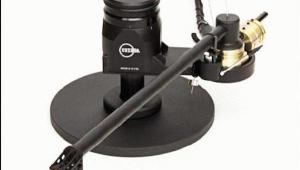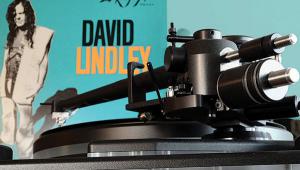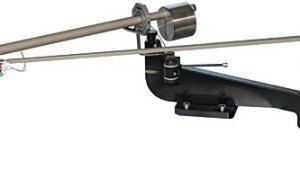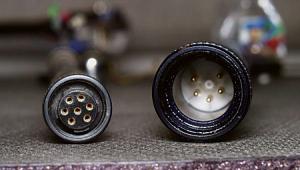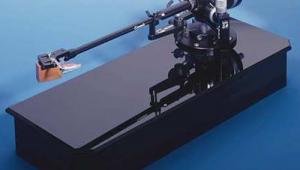HiFiction Thales AV tonearm Page 2
The HiFiction Thales AV
Designed and manufactured by Micha Huber, a fastidious young Swiss mechanical engineer, musician, and watchmaker, the HiFiction Thales AV tonearm ($12,360) offers the promise of a tonearm boasting the advantages of both pivoted and linear tangential-tracking arms, and the disadvantages of neither. He was granted a Swiss patent for the design in 2004.
The arm's geometrical basis is the Thales Circle (footnote 1). As Huber describes it, the design "reduces the perfectly tangential tracking to pivot points, while the pick-up cartridge is taken and aligned on the Thales Circle." You can examine the geometry via Huber's explanation and an interactive animation.
Basing a tonearm on the Thales Circle is said by Huber to produce four things: zero tracking error (which is difficult to prove in any way other than the mathematical); minimal friction using traditional pivoted bearings; a short tonearm with little resonance; and symmetrical inertia at the tracking point in all axes. While the principle is not much different from the one that inspired the Garrard Zero 100 all those years ago, the design and construction of the Thales AV is in another league altogether, as you can see in the photo.
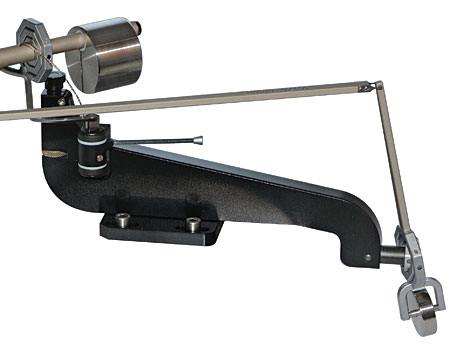
The arm itself is relatively short, with a conventional counterweight. At one end, the headshell pivots around a very low-friction, backlash-free bearing weighing a mere 1.62gm. This bearing may look like a simple point of rotation, but it contains 25 individual parts including two ball bearings, each comprising seven tiny balls and a precision adjustment mechanism.
The counterweight end of the arm holds one of the system's two cardanic (gyroscopic) bearings, which use four Vee Jewel bearings, each consisting of a steel shaft with a spherical end held in a conically indented sapphire. When these bearings are properly adjusted, Huber claims that there is no chatter, very low friction, and full control of energy flow. Indeed, the first time I met Huber, in Munich a few years ago, he showed me his bearing and gave it a spin. I don't recall it stopping on its own during the entire time we spoke.
Looking at the picture, you see a thin, two-piece mechanism comprising a long horizontal arm and a shorter vertical arm, attached to the back of the headshell (and the tonearm proper) by a pair of precision sapphire bearings. The horizontal and vertical arms are what maintain the tangency of the stylus to the groove. As the tonearm itself moves across the record, the vertical arm, attached to the horizontal arm with a set of sapphire bearings, acts to compensate for the change in length of the mechanism. It, too, is attached to the main base with a cardanic bearing. Thus, as the complete arm moves in an arc across the record, the headshell, guided by the secondary arm, pivots precisely to maintain groove tangency.
The arm and headshell of the Thales AV are made of aluminum alloyed with magnesium and silica. (The AV stands for "Aluminum Version.") The Thales Original arm ($13,360) is made of pure magnesium while the bearing parts are plated with gold. The parts are not "cold-formed" but cut from large cast blocks that, because the material is not mechanically stressed, is said to produce a more uniform pathway for the dissipation of vibrational energy.
Setup and Adjustments
While the Thales AV's baseplate is fairly standard, the downward travel of the vertical arm means that only turntables with sufficient rear/side clearance can be used (footnote 2). Large-plinthed 'tables will require a clearance hole to be cut in the plinth to accommodate the low-hanging rear cardanic bearing and the antiskating adjustment knob.
The Thales AV provides every adjustment function found on a conventional tonearm, including vertical tracking angle (VTA) and azimuth. The counterweight can be rotated—not to adjust azimuth, as on some unipivots, but to adjust for differences in vertical tracking force (VTF) that can occur with this design as the tonearm travels from the outer to the inner groove areas. You can adjust it for uniform VTF across the entire LP side, or have it automatically slightly increase the tracking force for the more-difficult-to-track inner grooves.
Setting up and using the Thales AV requires some new skills; while learning them, it's best to proceed with caution. HiFiction provides an overhang template similar to those used with conventional pivoted arms. The sliding counterweight makes precise adjustment of VTF less than convenient: a slight nudge can produce a big change in tracking force. You're instructed to adjust the grub screw so that the counterweight can only just be slid, but won't be moved by accident.
That grub screw's location, in a recess near the bottom of the counterweight, on the platter side, makes setting VTF even more difficult. Too tight, and the counterweight won't move; too loose, and it won't stay put. I can't understand why, in what is otherwise a work of precision art, Huber left unaddressed this not overly challenging problem. Once you've set the VTF, you should check it at both the start and end of an LP side. Discrepancies can be adjusted by rotating the counterweight as described in the manual.
A pair of tiny setscrews on the main cardanic bearing's outer ring provides some adjustability of azimuth. While VTA is easily adjusted on the fly by turning a small knurled knob in the tonearm's base (after loosening a setscrew), its location requires you to exercise extreme caution—you can easily bump the horizontal arm, thus setting off potential stylus-destroying movements of the entire assembly.
Footnote 1: Thales of Miletus, 625–547 B.C., was a Greek philosopher. The semicircle over the hypothenuse of a right triangle is sometimes called "Thales circle."—Ed.
Footnote 2: Mounting profiles are available for turntables from Audiostone Pythagoras, Brinkmann, Platine-Verdier, Thorens TD 124, Montegiro Lusso, Oracle (custom mounts available).—Michael Fremer
- Log in or register to post comments

